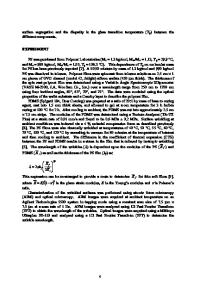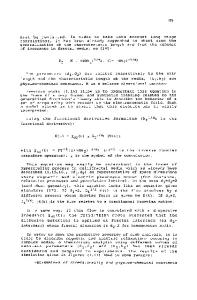Ab-initio Calculations to Model Anomalous Fluorine Behavior
- PDF / 176,032 Bytes
- 6 Pages / 612 x 792 pts (letter) Page_size
- 49 Downloads / 909 Views
Ab-initio Calculations to Model Anomalous Fluorine Behavior Milan Diebel1 and Scott T. Dunham2 1 Department of Physics, University of Washington, Seattle, WA 98195-1560, USA 2 Department of Electrical Engineering, University of Washington, Seattle, WA 98195-2500, USA ABSTRACT Implanted fluorine has been observed to behave unusually in silicon, manifesting apparent uphill diffusion [1]. We are further motivated to understand the behavior of implanted fluorine in silicon by experiments which suggest that fluorine reduces boron diffusion [2, 3, 4, 5] and enhances boron activation in shallow junctions [2, 3]. In order to investigate fluorine behavior, we calculated the energy of fluorine defect structures in the framework of density functional theory (DFT). Besides identifying the ground-state configuration of a single fluorine atom in silicon, a set of energetically favorable fluorine defect structures were found. The latter strongly suggests a distinct fluorine diffusion mechanism, which was implemented in a continuum diffusion simulation and compared to experimental data. INTRODUCTION As ULSI devices enter the nanoscale, ultra-shallow junctions become necessary. Reduction in transient enhanced diffusion (TED) and enhanced dopant activation are desired. Experimentally, fluorine has shown to have beneficial properties on both boron TED reduction [2, 3, 4, 5] as well as boron activation [2, 3]. However, to utilize these benefits effectively, a fundamental understanding of F behavior is necessary, particularly since F shows anomalous diffusion behavior [1]. Figure 3 shows data reported by Jeng et al. In the experiment, 1013 cm−2 F+ was implanted at 30 keV and annealed for 30 min at various temperatures. The anomaly consists of two key features. At temperatures below 550◦ C, no noticeable F diffusion takes place. However, at higher temperatures, rapid F diffusion is reported. Such a behavior indicates the formation of strongly bound F complexes, since ab-initio calculations give a migration barrier of only 0.7-1.3 eV, which indicates that interstitial F (Fi ) is a highly mobile species [8, 9]. The second part of the anomalous behavior is the shapes of the annealed profiles. Instead of a broadening, the annealed profiles sharpen and shift toward the surface. RESULTS The analysis is split into two sections. First, the ab-initio results are discussed. Then, a continuum model is developed using the first-principle data to compare to the anomalous fluorine behavior reported experimentally. Ab-initio Calculations In order to investigate fluorine behavior in silicon, the energies for various configurations were calculated using the DFT code VASP [10] with a PW91 GGA functional and ultra-soft
C4.5.1
Structure Eb last F [eV] Ebtot [eV] FV −2.38 −2.38 F2 V −2.25 −4.63 F3 V −1.95 −6.58 F4 V −0.54 −7.12 V2 — −1.45 FV2 −2.75 −4.20 F2 V2 −2.87 −7.07 F3 V2 −1.97 −9.04 F4 V2 −2.43 −11.47 F5 V2 −1.82 −13.29 F6 V2 −1.80 −15.09
Ef [eV] +1.00 −1.25 −3.20 −3.74 +5.31 +2.56 −0.31 −2.28 −4.71 −6.53 −8.33
Table 1: Binding energies of Fn Vm configurations. The decreasi
Data Loading...










